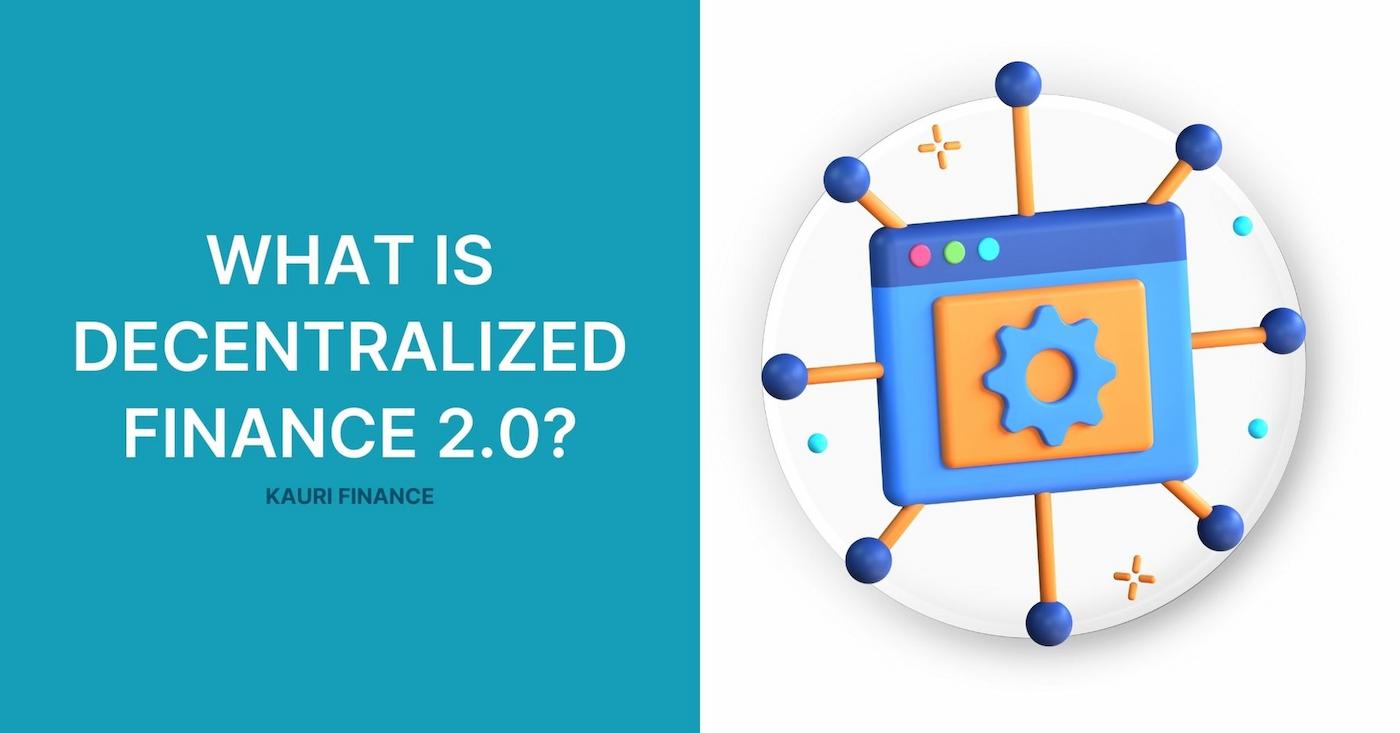
What is Decentralized Finance 2.0?

Since its inception, decentralized finance (DeFi) has rapidly transformed the financial sector, ushering in a new era of affordable financial services without traditional intermediaries. DeFi is currently evolving into what is known as DeFi 2.0, which aims to address the shortcomings of its original version by increasing scalability, improving user experience, and developing cross-chain interoperability.
For Kauri users, understanding DeFi 2.0 is crucial. After all, it not only opens up new investment opportunities, but also improves the way we interact with digital assets, creating more robust tools and innovative return strategies. In this article, we take a look at the key parameters of DeFi 2.0, tell you what it means and the new opportunities associated with DeFi.
What Is DeFi?
Decentralized Finance, commonly known as DeFi, represents a shift in the financial sector towards decentralized structures, fundamentally changing how financial services are accessed and delivered. Built on public blockchains such as Ethereum, Solana, and Tron, DeFi removes the traditional centralized intermediaries like banks and brokers, enabling direct peer-to-peer financial transactions.
Key Differences from Traditional Finance:
- Elimination of Intermediaries: Unlike traditional finance, DeFi operates without central authorities, meaning no single entity controls the market. This not only reduces costs by cutting out middlemen but also increases transparency and trust among users.
- Direct Access through dApps: Services in DeFi are delivered through decentralized applications (dApps), which are automated programs running on a blockchain. These dApps handle everything from currency exchanges to complex financial instruments, accessible directly from a user’s digital wallet.
Primary Features of Early DeFi (DeFi 1.0):
- Stablecoins: One of the foundational elements of DeFi, stablecoins like USDT and DAI, provide a stable medium of exchange pegged to traditional fiat currencies, typically the US dollar. These are crucial for reducing the inherent volatility of cryptocurrencies and making DeFi more practical for everyday transactions and financial planning.
- Decentralized Exchanges (DEXs): Unlike traditional exchanges, DEXs allow users to swap cryptocurrencies directly with one another without needing an intermediary. This not only enhances security by allowing users to retain control of their private keys but also increases the resilience of the financial system against censorship and centralized failure points.
- Yield Farming: Emerging as a popular feature in DeFi, yield farming involves users staking or lending their cryptocurrencies in return for interest payments or other rewards. This has been instrumental in providing liquidity to the DeFi ecosystem and incentivizing participation and growth.
These pioneering features of DeFi have set the stage for more innovative financial solutions, fostering a culture of open, inclusive, and efficient financial markets. As we move towards DeFi 2.0, these foundational elements continue to evolve, bringing more sophisticated financial strategies and solutions to the forefront.
What Is DeFi 2.0?
DeFi 2.0 represents the next evolutionary phase in the decentralized finance landscape, designed to address and overcome the primary challenges that emerged with the initial wave of DeFi applications. These challenges include scalability issues that limit transaction speed and volume, and interoperability constraints that isolate assets and services on separate blockchain platforms.
Key Features of DeFi 2.0:
- Improved Scalability: DeFi 2.0 introduces solutions that enhance the underlying blockchain architectures, such as Layer 2 scaling solutions and sharding, to handle more transactions at lower costs. This scalability is crucial for supporting a larger user base and more complex applications without compromising speed or security.
- Enhanced User Experience: Recognizing that user adoption hinges on ease of use, DeFi 2.0 focuses on streamlining interfaces and simplifying interactions within the DeFi ecosystems. This involves more intuitive dApp designs, better integration with web and mobile platforms, and simpler transaction processes that attract a broader audience.
- Cross-chain Interoperability: DeFi 2.0 emphasizes the development of technologies that enable seamless interactions between different blockchain platforms. Through cross-chain bridges and other interoperability solutions, assets and data can fluidly move between blockchains, vastly expanding the potential for innovation and integration across the DeFi space.
- Optimized Yield Farming Opportunities: Advanced algorithms and new financial instruments in DeFi 2.0 allow for more sophisticated strategies in yield farming. These optimizations aim to provide higher returns, better risk management, and more sustainable farming incentives that attract and retain liquidity providers.
- Advanced On-chain Governance: DeFi 2.0 enhances the mechanisms through which users can propose, vote on, and implement changes within DeFi protocols. More effective governance models are being developed to ensure that these platforms remain flexible and responsive to the community's needs.
- Development of a Competitive Oracle Market: Recognizing the critical role of oracles in connecting DeFi with real-world data, DeFi 2.0 supports the growth of a more robust and competitive market for oracle services. This diversity helps ensure that the data feeding into smart contracts is accurate and secure, reducing reliance on any single source and mitigating associated risks.
These features of DeFi 2.0 are not just iterative improvements but significant enhancements that address the foundational challenges of DeFi 1.0. By solving these issues, DeFi 2.0 aims to create a more resilient, efficient, and user-friendly financial ecosystem that could rival and potentially surpass traditional financial systems.
New Hikes in DeFi 2.0
DeFi 2.0 brings with it a host of advancements and opportunities that promise to further enhance the capabilities and reach of decentralized finance. From leveraging new technologies for improved performance to fostering more extensive ecosystem interactions, the landscape is ripe with potential for innovation and growth.
Enhancing Scalability with Layer 2 Solutions:
- Role of L2 Scaling: Layer 2 (L2) solutions play a critical role in addressing one of the most significant challenges faced by DeFi platforms: scalability. By handling transactions off the main blockchain (Layer 1) and only settling final states on-chain, L2 solutions such as rollups and sidechains can drastically increase transaction throughput while reducing costs.
- Impact on DeFi Applications: These enhancements make DeFi applications faster and cheaper to use, appealing to a broader user base and potentially driving greater adoption. This scalability is crucial for complex operations like high-frequency trading and sophisticated financial instruments, which require quick and cost-effective transaction processing.
Cross-Chain Interoperability:
- Expanding DeFi's Reach: Cross-chain interoperability refers to the ability of different blockchain networks to communicate and share information, allowing for the seamless transfer of assets across disparate platforms. This interoperability breaks down the barriers between isolated blockchains, enabling a more integrated DeFi ecosystem.
- Capital Flow and Innovation: By facilitating the movement of assets across chains, interoperability not only enhances liquidity within DeFi markets but also encourages broader participation and innovation. This openness fosters a more vibrant development environment where projects from different blockchains can collaborate and build on each other’s strengths.
Customizability in DeFi Platforms:
- Tailored DeFi Solutions: Advanced customizability is becoming a hallmark of DeFi 2.0, with platforms like Cosmos leading the way. These platforms allow developers to build bespoke blockchain solutions that cater specifically to their DeFi applications’ needs, be it around governance, transaction speed, or specific financial services.
- Benefits of Customization: This trend towards customization enables DeFi projects to optimize their infrastructure for specific use cases, improving performance and user experience. It also allows for more experimental and niche applications, broadening the scope of DeFi services available to users.
Innovative Yield Farming Strategies:
- Emergence of New Strategies: DeFi 2.0 introduces more sophisticated yield farming techniques, such as liquid staking and leveraged staking. These methods provide users with enhanced ways to earn returns on their crypto assets.
- Rewards and Risks: While these new strategies can offer higher yields, they also come with increased risk. For example, leveraged staking amplifies both potential returns and potential losses, making it important for users to understand the mechanisms and risks involved thoroughly.
New Advances in Chain Management and Data Oracles
Evolving On-Chain Governance:
- Empowering Users: DeFi 2.0 platforms are increasingly incorporating sophisticated on-chain governance mechanisms that allow users more substantial input in protocol decision-making. This evolution from more traditional, often opaque decision-making processes towards a transparent and inclusive approach means that anyone holding governance tokens can propose, vote on, or implement changes within the protocol.
- Benefits of Enhanced Governance: This democratization not only aligns the interests of users with the long-term health and development of the protocol but also fosters a sense of community and ownership, which is vital for the sustained success and credibility of DeFi projects.
Competitive Oracle Markets:
- Importance of Reliable Data Sources: Oracles play a critical role in DeFi by providing accurate, real-time data that smart contracts need to execute transactions based on external information. The reliability of these data sources directly impacts the security and efficiency of DeFi applications.
- Growing Market Competition: The oracle market is witnessing increased competition, which serves to enhance the quality and reliability of the services provided. With multiple providers, DeFi platforms can avoid reliance on a single oracle, which diversifies risk and may lead to more competitive pricing and innovative services.
Enhancing User Experience in DeFi
Current Improvements:
- Simplifying Access: Access to DeFi platforms has significantly improved with integrations like Wallet Connect, which allows users to interact with dApps across multiple devices without compromising security. This tool and similar technologies enable users to connect their wallets quickly to DeFi platforms without the cumbersome need for repetitive log-ins or complex installations.
- Wallet Security and Efficiency: Advances in wallet technology have not only made transactions safer but also more user-friendly. Modern crypto wallets now often include features that streamline the transaction process, reduce fees, and enhance security, making DeFi more accessible to a broader audience.
Future Enhancements:
- Predictions for User Interaction: Looking ahead, we can expect even more user-focused innovations in DeFi. These might include the development of more intuitive user interfaces, integrated services that combine multiple DeFi applications into single platforms for easier management, and further improvements in cross-chain interactions.
- Seamless DeFi Experiences: As the underlying technology matures and developers gain more insight into user behavior, future enhancements are likely to focus on creating a seamless experience that rivals traditional finance, reducing the learning curve for new users and enhancing the efficiency for seasoned traders.
Conclusion
As DeFi 2.0 reshapes the financial landscape, it offers a more robust, efficient, and user-friendly system that leverages the best of blockchain technology. With advancements such as enhanced scalability, improved governance, and increased interoperability, DeFi 2.0 is poised to broaden access to financial services like never before.
We encourage you to dive into the evolving world of DeFi and explore the opportunities DeFi 2.0 brings. Stay informed and make educated decisions by following updates and guides here on KAURI FINANCE. Engage with us as we navigate this innovative financial frontier together, and take full advantage of what DeFi 2.0 has to offer.
